Saudi Arabia’s Journey toward Net-Zero Emissions: Progress and Challenges
Abstract
1. Introduction
2. Methodology
- Will Saudi Arabia be able to reach NZE by 2060?
- Are Saudi measures to reduce emissions sufficient?
3. Literature Review
3.1. GHG
3.2. The Paris Climate Agreement
- Achieving NZE in the second half of this century.
- Application of mitigation measures of individual countries to be expressed in NDCs.
- NDCs should be revised at least every five years to reflect the advancements since the last iteration.
- Using emission trading or by permitting result-based payments, countries can transfer the results of their mitigation efforts globally to fulfill their NDC commitments.
- Providing $100 billion per year until 2025 and $100 billion after 2025 as a floor. Developing nations are urged to offer voluntary assistance. The significance of public monies in finance is essential. Developed nations are required to submit reports twice a year on the extent of the aid given.
3.3. Measures to Reduce and Remove GHG Emissions
3.3.1. Policies
- Carbon cap policy.
- Carbon tax policy
- Cap-and-trade policy (carbon trading policy).
- Carbon subsidy policy.
- Carbon offset policy.
- Carbon cap-and-price policy.
- Carbon banking-and-borrowing policy.
3.3.2. Strategies
- Energy efficiency.
- Energy conservation.
- Fuel switching.
- Removal of fossil fuel subsidies.
- Removal of the tax differential between diesel and gasoline.
3.3.3. Carbon Capture Technology
3.3.4. Plantation and Forestation
3.3.5. Circular Carbon Economy (CCE)
4. Saudi 2021 Nationally Determined Contribution
- Energy efficiency. This includes maximizing the efficiency of home appliances and air-conditioning units, feedstock utilization, improving the fuel economy of transportation fleets, phasing out inefficient and used light-duty vehicles, implementing aerodynamic regulations for heavy-duty vehicles, and improving thermal efficiency.
- Renewable energy. By 2030, Saudi Arabia plans to use renewable energy for 50% of its energy mix. Saudi Arabia will conduct research and development and manufacture renewable energy products as part of its efforts to localize renewable energy. Renewable energy sources include solar photovoltaics (PVs), concentrated solar power, wind power, geothermal power, and waste-to-energy.
- Green hydrogen. A green hydrogen facility will be built as part of the Saudi mega project “NEOM.”
- CCUS. The state is planning to build the world’s largest CCUS plant as part of the national CCE program.
- Utilization of gas. Saudi Arabia is working on increasing the utilization of natural gas in its energy mix to represent up to 50% of its electricity generation by 2030.
- Methane management. By adopting zero flaring in the oil and gas industry, recovery, and subsequent usage for power generation and petrochemical manufacturing, methane emissions will be reduced.
5. Emission Forecast Analysis for Saudi Arabia
5.1. Electricity Generation
- 50% of the power will be from renewable sources by 2030 [20].
- 50% of the power will be from natural gas by 2030 [30].
- Currently, renewable energy represents less than 1% of the power industry.
- Currently, 40% of electricity comes from oil, and 60% comes from gas [18].
- Natural gas produces 52.91 kg of CO2 per million British thermal units (BTU), while residual heating fuel produces 75.09 kg of CO2 per million BTU [40]. In addition, the standard emission factors based on the average carbon content of crude oil and natural gas are 3.07 tons of CO2 and 2.35 tons of CO2 per ton of oil equivalent, respectively [4]. Many factors determine the reduction in replacing oil with gas for power generation. Nevertheless, it is estimated as a ~30% reduction in CO2 emissions. This means that currently, oil (including diesel and heavy fuel) represents 40% of power generation, while gas accounts for the rest (60%), and the contribution of oil to the total CO2 emissions is approximately 52% in the power industry.
- The growth in demand until 2030 will remain at approximately 2%. Even if the demand increases by more than 2%, the contribution of the initiatives (e.g., energy efficiency initiatives) would adjust the results. For example, the initiative calls for replacing more than 2.7 million higher-energy sodium vapor light bulbs that illuminate the Kingdom’s roads with modern, more efficient LED units that comply with the energy efficiency standards [41]. The government established the Energy Efficiency Program, which is responsible for the development of new energy efficiency standards in power generation, water desalination, and electricity transmission and distribution [42]. On the contrary, the statistics over the past few years show an annual increase in demand for electricity of <2% [37].
5.2. Road Transport
5.3. Desalination
- RO technology.
- Renewable energy for seawater desalination.
- Minimizing leaks in the potable water distribution system.
- Increasing the use of treated wastewater.
- Rainwater harvesting.
- Storage of surface water runoff.
- New irrigation techniques.
5.4. Petroleum, Refining, and Well Testing
- Energy efficiency through several approved initiatives, including gas turbine upgrades and boiler and heater efficiency improvement.
- Methane and flaring. The company is committed to reaching zero routine flaring by 2030.
- Renewables. The company is investing in 12 GW solar PV and wind projects. It is working with its affiliates in investing in renewables and is also evaluating contributing 2.3 GW to renewable projects.
- CCUS. The company has set a goal of developing its CCUS capacity to capture up to 11 Mt of CO2eq by 2035.
- Offsets. The company is planning to plant 300 million mangroves nationally and 350 million mangroves abroad by 2035.
5.5. Petrochemical, Fertilizer, and Ammonia Industries
5.6. Petrochemical Production
5.7. Cement Production and Industries
5.8. Steel and Iron
- The growth in demand will be approximately 2%.
- The Saudi iron and steel company added will still dominate 45% of Saudi production.
- SABIC will fulfill its pledge and reach NZE by 2050. Subsequently, the Saudi iron and steel company, which is fully owned by SABIC, will reach NZE by 2050.
- Hadeed (the largest steel company) emissions will decrease evenly from 2030 until reaching NZE by 2050. The other companies will not make a significant reduction in emissions.
5.9. Other Sources (Miscellaneous)
5.10. Carbon Sink
- Marine protection. Saudi Arabia is encouraging the plantation of mangrove seedlings along its coasts. Studies have been conducted to estimate the outtake of mangroves and other blue carbons for the Red Sea and the Arabian Gulf.
- Reduced desertification and tree planting. As part of its green initiative, Saudi Arabia is planning to create a green carbon sink by planting trees and rehabilitating hectares of land.
5.11. Overall Future Emissions
6. Discussion
7. Conclusions
- The Saudi government shall continue with its current investments and measures in the fields of energy efficiency, renewable energy, and nuclear energy to ensure achieving NZE from the electricity generation sector by 2060.
- The government shall facilitate and proceed with more initiatives and investments in the fields of public and green transportation since the transportation sector is the second source of emissions (166.65 Mt of CO2eq per year).
- Since the emissions from the cement sector are forecasted to be ~138.5 Mt of CO2eq by 2060, innovation and investments in new technologies for low-carbon, energy-efficient cement plants shall be developed and made to keep pace with a changing world, and the cement industry is encouraged to pursue zero carbon emissions. Additionally, a pertinent regulatory framework must be created.
- The total carbon capture associated with afforestation and reforestation should be enhanced by substituting long-lived trees and using harvested wood products for construction materials since afforestation and reforestation are the carbon sink that shall provide 250 Mt of CO2eq sequestration.
- Planting trees that would create value, such as trees that can be used in the pharmaceutical industry, should also be considered since the required investment in the green initiative is huge.
- CO2 sequestered from CCUS should be used for the generation of products with high value to reduce the cost of CCUS. For example, more research should focus on manufacturing graphene from sequestered CO2.
- The economic implications of imposing a carbon tax should be assessed.
- Exporting blue and green hydrogen should be further studied in the context of Saudi Arabia.
Author Contributions
Funding
Data Availability Statement
Conflicts of Interest
References
- Binyam, A. The Role of Forest and Soil Carbon Sequestrations on Climate Change Mitigation. J. Environ. Earth Sci. 2014, 4, 98–111. [Google Scholar]
- The Royal Society; Royal Academy of Engineering. Greenhouse Gas Removal Report. The Royal Society, September 2018. Available online: https://royalsociety.org/-/media/policy/projects/greenhouse-gas-removal/royal-society-greenhouse-gas-removal-report-2018.pdf (accessed on 28 August 2022).
- Streck, C.; Keenlyside, P.; von Unger, M. The Paris Agreement: A New Beginning. J. Eur. Environ. Plan. Law 2016, 13, 3–29. [Google Scholar] [CrossRef]
- Hamieh, A.; Rowaihy, F.; Al-Juaied, M.; Abo-Khatwa, A.N.; Alafifi, A.M.; Hoteit, H. Quantification and Analysis of CO2 Footprint from Industrial Facilities in Saudi Arabia. Energy Convers. Manag. X. 2022, 16, 100299. [Google Scholar] [CrossRef]
- IPCC. 2006 IPCC Guidelines for National Greenhouse Gas Inventories. Available online: https://www.ipcc-nggip.iges.or.jp/public/2006gl/ (accessed on 17 September 2022).
- OECD; IEA; NEA; ITF. Aligning Policies for a Low-Carbon Economy; OECD Publishing: Paris, France, 2015. [Google Scholar] [CrossRef]
- Xu, Z.; Elomri, A.; Pokharel, S.; Mutlu, F. The Design of Green Supply Chains under Carbon Policies: A Literature Review of Quantitative Models. Sustainability 2019, 11, 3094. [Google Scholar] [CrossRef]
- Kiss, T.; Popovics, S. Evaluation on the effectiveness of Energy Policies—Evidence from the Carbon Reductions in 25 Countries. Renew. Sustain. Energy Rev. 2021, 149, 111348. [Google Scholar] [CrossRef]
- Gurtu, A.; Vyas, V.; Gurtu, A. Emissions Reduction Policies and Their Effects on Economy. J. Risk Financ. Manag. 2022, 15, 404. [Google Scholar] [CrossRef]
- Ghazouani, A.; Xia, W.; Ben Jebli, M.; Shahzad, U. Exploring the Role of Carbon Taxation Policies on CO2 Emissions: Contextual Evidence from Tax Implementation and Non-Implementation European Countries. Sustainability 2020, 12, 8680. [Google Scholar] [CrossRef]
- Al-Sinan, M.A.; Bubshait, A.A. The Procurement Agenda for the Transition to a Circular Economy. Sustainability 2022, 14, 11528. [Google Scholar] [CrossRef]
- United States Environmental Protection Agency. Greenhouse Gas (GHG) Emissions and Removals. Available online: https://www.epa.gov/ghgemissions (accessed on 28 August 2022).
- Madejski, P.; Chmiel, K.; Subramanian, N.; Ku´s, T. Methods and Techniques for CO2 Capture: Review of Potential Solutions and Applications in Modern Energy Technologies. Energies 2022, 15, 887. [Google Scholar] [CrossRef]
- Liu, H.J.; Were, P.; Li, Q.; Gou, Y.; Hou, Z. Worldwide Status of CCUS Technologies and Their Development and Challenges in China. Geofluids 2017, 2017, 6126505. [Google Scholar] [CrossRef]
- Molina-Jirón, C.; Chellali, M.R.; Shyam Kumar, C.N.; Kübel, C.; Velasco, L.; Hahn, H.; Moreno-Pineda, E.; Ruben, M. Direct Conversion of CO₂ to Multi-Layer Graphene using Copper-Palladium Alloys. ChemSusChem 2019, 12, 3509. [Google Scholar] [CrossRef] [PubMed]
- Jeffery, L.; Höhne, N.; Moisio, M.; Day, T.; Lawless, B. Options for Supporting Carbon Dioxide Removal. NewClimate Institute, 28 July 2020. Available online: https://newclimate.org/sites/default/files/2020/07/Options-for-supporting-Carbon-Dioxide-Removal_July_2020.pdf (accessed on 7 September 2022).
- Kongsager, R.; Napier, J.; Mertz, O. The Carbon Sequestration Potential of Tree Crop Plantations. Mitig. Adapt. Strateg. Glob. Chang. 2013, 18, 1197–1213. [Google Scholar] [CrossRef]
- Babonneau, F.; Badran, A.; Haurie, A.; Schenckery, M.; Vielle, M. GCC Countries Strategic Options in a Global Transition to Zero-Net Emissions. Research Square, 11 May 2022. Available online: https://doi.org/10.21203/rs.3.rs-1618600/v1 (accessed on 20 December 2022).
- Luomi, M.; Yilmaz, F.; Al Shehri, T. The Gulf Cooperation Council and the Circular Carbon Economy: Progress and Potential; King Abdullah Petroleum Studies and Research Center (KAPSARC): Riyadh, Saudi Arabia, 2022; Available online: https://doi.org/10.30573/KS--2022-DP06 (accessed on 20 December 2022).
- United Nations Climate Change, Saudi Arabia First NDC (Updated Submission). Available online: https://unfccc.int/documents/497886 (accessed on 14 August 2022).
- Mohajan, H.K. Greenhouse Gas Emissions Increase Global Warming. Int. J. Econ. Political Integr. 2011, 1, 21–34. [Google Scholar]
- International Plant Protection Convention (IPPC). B. Glossary of Terms. Available online: https://www.ipcc.ch/site/assets/uploads/2018/03/wg2TARannexB.pdf (accessed on 17 October 2022).
- Hertwich, E.G.; Wood, R. The Growing Importance of Scope 3 Greenhouse Gas Emissions from Industry. Environ. Res. Lett. 2018, 13, 104013. [Google Scholar] [CrossRef]
- Lippke, B.; Puettmann, M.; Oneil, E.; Chadwick, O. The Plant a Trillion Trees Campaign to Reduce Global Warming—Fleshing Out the Concept. J. Sustain. For. 2021, 40, 1–31. [Google Scholar] [CrossRef]
- United Nations. Paris Agreement. United Nations Climate Change. 2015. Available online: https://unfccc.int/sites/default/files/english_paris_agreement.pdf (accessed on 11 August 2022).
- Wogan, D.; Carey, E.; Cooke, D. Policy Pathways to Meet Saudi Arabia’s Contributions to the Paris Agreement; King Abdullah Petroleum Studies and Research Center (KAPSARC): Riyadh, Saudi Arabia, 2019. [Google Scholar] [CrossRef]
- DNA. First Biannual Update Report (BUR), Saudi Arabia. 2018. Available online: https://cdmdna.gov.sa/ (accessed on 7 August 2022).
- Rypdal, K.; Winiwarter, W. Uncertainties in Greenhouse Gas Emission Inventories—Evaluation, Comparability and Implications. Environ. Sci. Policy. 2001, 4, 107–116. [Google Scholar] [CrossRef]
- Zhang, J.; Liu, J.; Dong, L.; Qiao, Q. CO2 Emissions Inventory and Its Uncertainty Analysis of China’s Industrial Parks: A Case Study of the Maanshan Economic and Technological Development Area. Int. J. Environ. Res. Public Health 2022, 19, 11684. [Google Scholar] [CrossRef]
- Houghton, J.T.; Meira Filho, L.G.; Lim, B.; Treanton, K.; Mamaty, I.; Bonduki, Y.; Griggs, D.J.; Callander, B.A.; IPCC. Greenhouse Gas Inventory Reporting Instructions; Revised 1996 IPCC Guidelines for National Greenhouse Gas Inventories. Volumes 1, 2 and 3; Intergovernmental Panel on Climatic Change (IPCC), WGI Technical Support Unit: London, UK, 1997. [Google Scholar]
- Fourth National Communication (NC4) Kingdom of Saudi Arabia. Submitted to The United Nations Framework Convention on Climate Change (UNFCCC) March 2022. United Nations Climate Change. 2022. Available online: https://unfccc.int/sites/default/files/resource/7123846_Saudi%20Arabia-NC4-1-Fourth%20National%20Communication%20NC4%20Kingdom%20of%20Saudi%20Arabia%20March%202022.pdf (accessed on 5 August 2022).
- CO2 Emissions (Metric Tons per Capita)—Saudi Arabia. The World Bank. Available online: https://data.worldbank.org/indicator/EN.ATM.CO2E.PC?locations=SA (accessed on 1 September 2022).
- Carbon Footprint by Country 2022. World Population Review. Available online: https://worldpopulationreview.com/country-rankings/carbon-footprint-by-country (accessed on 7 September 2022).
- United Nations Environment Programme. State of the Climate. UN Environment Programme, 9 November 2021. Available online: https://www.unep.org/explore-topics/climate-action/what-we-do/climate-action-note/state-of-climate.html?gclid=EAIaIQobChMI7uqL_I28-gIVV-d3Ch2ZQQ76EAAY (accessed on 7 September 2022).
- Ritchie, H.; Roser, M. Saudi Arabia: CO2 Country Profile. Our World in Data (OWID). Available online: https://ourworldindata.org/co2/country/saudi-arabia (accessed on 15 August 2022).
- Saqib, N. Greenhouse Gas Emissions, Energy Consumption and Economic Growth: Empirical Evidence from Gulf Cooperation Council Countries. IJEEP 2018, 8, 392–400. [Google Scholar] [CrossRef]
- Sustainability Report: SEC Environmental, Social and Governance (ESG) Report 2021. Saudi Electricity Company. 2022. Available online: https://www.se.com.sa/en-us/invshareholder/Pages/sustainabilityreport.aspx (accessed on 26 September 2022).
- Electrical Statistic 2020. General Authority for Statistics, Kingdom of Saudi Arabia. Available online: https://www.stats.gov.sa/sites/default/files/Electrical%20Energy%20Statistics%202020EN_0.pdf (accessed on 10 October 2022).
- Sustainability Report: SEC Environmental, Social and Governance (ESG) Report 2019. Saudi Electricity Company. 2020. Available online: https://www.se.com.sa/en-us/invshareholder/Pages/sustainabilityreport.aspx (accessed on 9 October 2022).
- Carbon Dioxide Emissions Coefficients. US Energy Information Administration. 5 October 2022. Available online: https://www.eia.gov/environment/emissions/co2_vol_mass.php (accessed on 7 October 2022).
- Sustainability in Focus: Saudi Wealth Fund PIF’s Path to Net Zero Emissions. Al Arabiya News. 13 September 2022. Available online: https://english.alarabiya.net/business/energy/2022/09/13/Sustainability-in-focus-Saudi-wealth-fund-PIF-s-path-to-net-zero-emissions (accessed on 7 October 2022).
- Reducing Emissions. Saudi Green Initiative. Available online: https://www.saudigreeninitiative.org/targets/reducing-emissions/ (accessed on 3 September 2022).
- Amran, Y.A.; Amran, Y.M.; Alyousef, R.; Alabduljabbar, H. Renewable and Sustainable Energy Production in Saudi Arabia According to Saudi Vision 2030. Current Status and Future Prospects. J. Clean. Prod. 2020, 247, 119602. [Google Scholar] [CrossRef]
- Saudi Arabia to Triple Size of Its Rail Network. Arab News, 13 January 2022. Available online: https://www.arabnews.com/node/2003401/business-economy (accessed on 27 September 2022).
- Riyadh Metro Project Nearing Completion. Saudi Gazette, 16 December 2021. Available online: https://saudigazette.com.sa/article/614806/SAUDI-ARABIA/Riyadh-Metro-project-nearing-completion-nbsp (accessed on 7 October 2022).
- Saudi Arabia Registered Motor Vehicles. International Organization of Motor Vehicle Manufactures. Available online: https://www.ceicdata.com/en/indicator/saudi-arabia/motor-vehicle-registered (accessed on 15 September 2022).
- Plumer, B.; Tabuchi, H. 6 Automakers and 30 Countries Say They’ll Phase Out Gasoline Car Sales. The New York Times, 9 November 2021. Available online: https://www.nytimes.com/2021/11/09/climate/cars-zero-emissions-cop26.html (accessed on 7 October 2022).
- News Wires. The European Union Approved Ending the Sale of Vehicles with Combustion Engines by 2035 in Europe, the 27-Member Bloc Announced Early Wednesday, in a Bid to Reduce CO2 Emissions to Zero. France 24, 29 June 2021. Available online: https://www.france24.com/en/europe/20220629-eu-agrees-to-ending-sales-of-combustion-engine-vehicles-by-2035 (accessed on 17 October 2022).
- Alnajdi, O.; Wu, Y.; Kaiser Calautit, J. Toward a Sustainable Decentralized Water Supply: Review of Adsorption Desorption Desalination (ADD) and Current Technologies: Saudi Arabia (SA) as a Case Study. Water 2020, 12, 1111. [Google Scholar] [CrossRef]
- Desalination Reduce Carbon Emissions by 22% of Saudi Arabia Total Targets. Asharq Al-Awsat, 19 March 2021. Available online: https://english.aawsat.com/home/article/2869251/desalination-reduces-carbon-emissions-22-saudi-arabia’s-total-targets (accessed on 10 October 2022).
- Saudi Aramco. Saudi Aramco Sustainability Report 2021. Available online: https://www.aramco.com/en/sustainability/sustainability-report (accessed on 4 September 2022).
- Rahman, M.M.; Rahman, M.S.; Chowdhury, S.R.; Elhaj, A.; Razzak, S.A.; Abu Shoaib, S.; Islam, M.K.; Islam, M.M.; Rushd, S.; Rahman, S.M. Greenhouse Gas Emissions in the Industrial Processes and Product Use Sector of Saudi Arabia—An Emerging Challenge. Sustainability 2022, 14, 7388. [Google Scholar] [CrossRef]
- SABIC. Reimaging ESG. Toward a Circular Economy. Sustainability Report 2021. SABIC, 2022. Available online: https://www.sabic.com/assets/en/Images/SABIC_Sustainability_Report_2021_EN_tcm1010-34677.pdf (accessed on 10 October 2022).
- Largest Steel Companies in Saudi Arabia. Marcopolis, 2 November 2015. Available online: https://marcopolis.net/largest-steel-companies-in-saudi-arabia.htm (accessed on 23 September 2022).
- SABIC. Metals (Hadeed). SABIC, 2022. Available online: https://www.sabic.com/en/reports/annual-2021/our-businesses/metals (accessed on 14 October 2022).
- Hoffmann, C.; van Hoey, M.; Zeumer, B. Decarbonization Challenges for Steel. McKinsey & Company, 3 June 2020. Available online: https://www.mckinsey.com/industries/metals-and-mining/our-insights/decarbonization-challenge-for-steel (accessed on 15 October 2022).
- Sadara. ESG Report 2021. Sadara, 2022. Available online: https://www.sadara.com/en/About/Citizenship (accessed on 11 October 2022).
- Alami, M.; Wael, S.; Alasaeed, A. Saudi Megaprojects Set to Revive Cement Industry in 2022 After a Disappointing Year. Arab News, 16 April 2022. Available online: https://www.arabnews.com/node/2064551/business-economy (accessed on 18 October 2022).
- Production of Crude Steel in Saudi Arabia from 2014 to 2021 (in Million Metric Tons). Statista, 13 September 2022. Available online: https://www.statista.com/statistics/718271/saudi-arabia-crude-steel-production/ (accessed on 7 October 2022).
- Busch, P.; Kendall, A.; Murphy, C.W.; Miller, S.A. Literature Review on Policies to Mitigate GHG Emissions for Cement and Concrete. Resour. Conserv. Recycl. 2022, 182, 106278. [Google Scholar] [CrossRef]
- Technology Roadmap. Low-Carbon Transition in the Cement Industry. IEA. 2018. Available online: https://iea.blob.core.windows.net/assets/cbaa3da1-fd61-4c2a-8719-31538f59b54f/TechnologyRoadmapLowCarbonTransitionintheCementIndustry.pdf (accessed on 5 October 2022).
- Adesina, A. Recent Advances in the Concrete Industry to Reduce Its Carbon Dioxide Emissions. Environ. Chall. 2020, 1, 100004. [Google Scholar] [CrossRef]
- Al-Sinan, M.A.; Bubshait, A.A. Using Plastic Sand as a Construction Material toward a Circular Economy: A Review. Sustainability 2022, 14, 6446. [Google Scholar] [CrossRef]
- King Abdullah University of Science and Technology. Environmentally Friendly Cement Blend. King Abdullah University of Science and Technology. Available online: https://innovation.kaust.edu.sa/technologies/environmentally-friendly-cement-blend/ (accessed on 19 October 2022).
- Husain, S.F.; Shariq, M.; Masood, A. GFRP Bars for RC Structures—A Review. In Proceedings of the International Conference on Advances in Construction Materials and Structures (ACMS-2018), IIT Roorkee, Roorkee, Uttarakhand, India, 7–8 March 2018. [Google Scholar]
- Liu, H.; Garcia Tellez, B.; Atallah, T.; Barghouty, M. The role of CO2 capture and storage in Saudi Arabia’s energy future. Int. J. Greenh. Gas Control. 2012, 11, 163–171. [Google Scholar] [CrossRef]
- Schmelz, W.J.; Hochman, G.; Miller, K.G. Total Cost of Carbon Capture and Storage Implemented at a Regional Scale: North-Eastern and Midwestern United States. Interface Focus. 2020, 10, 20190065. [Google Scholar] [CrossRef]
- Girish, K.; Shankara Bhat, S. Neem—A Green Treasure. Electron. J. Biol. 2008, 4, 102–111. [Google Scholar]
- Arab News, Saudi Arabia Presents 66 Initiatives to Tackle Climate Change at COP27 in Egypt. Arab. News, 8 November 2022. Available online: https://www.arabnews.com/node/2195796/business-economy (accessed on 13 November 2022).
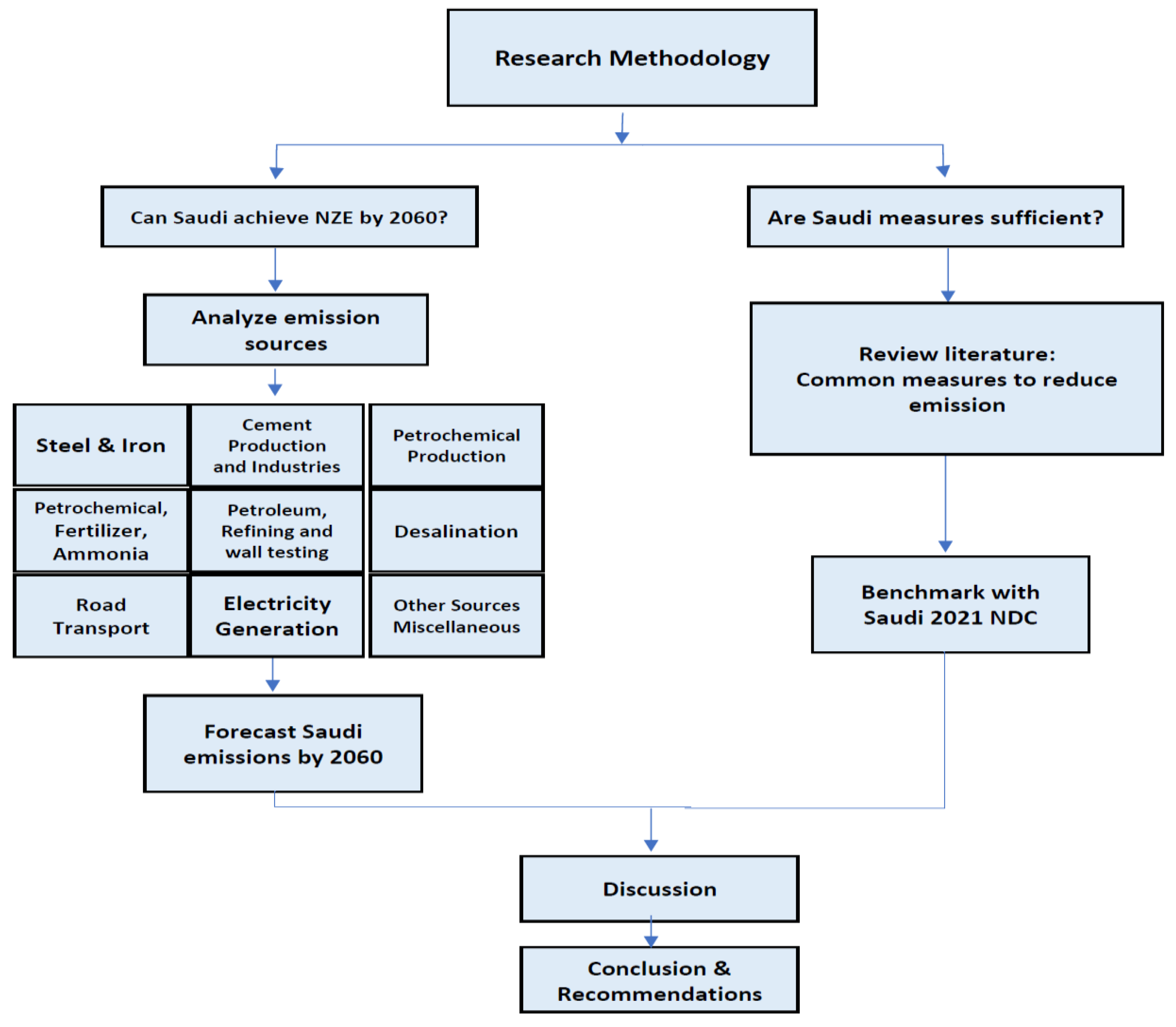
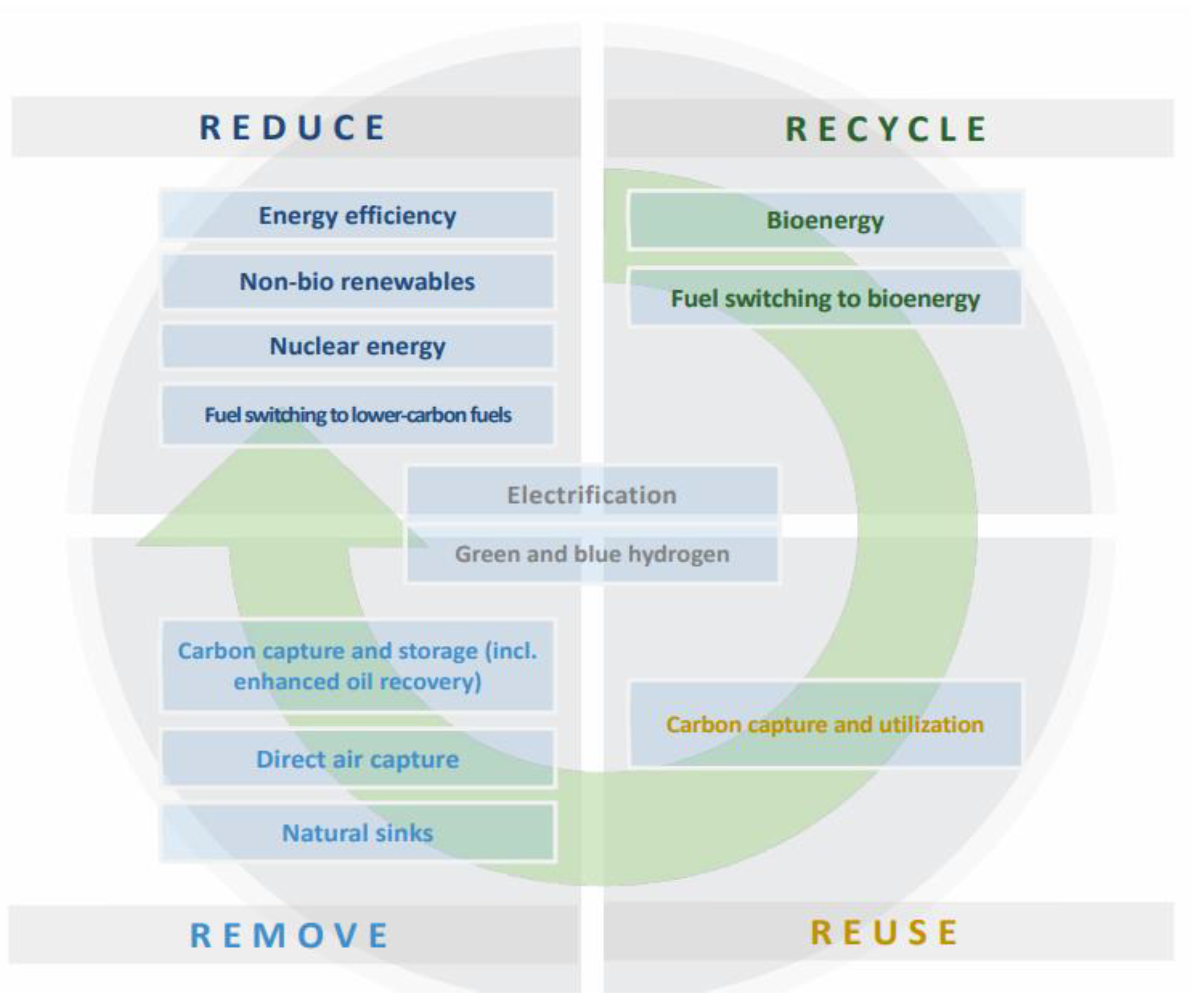
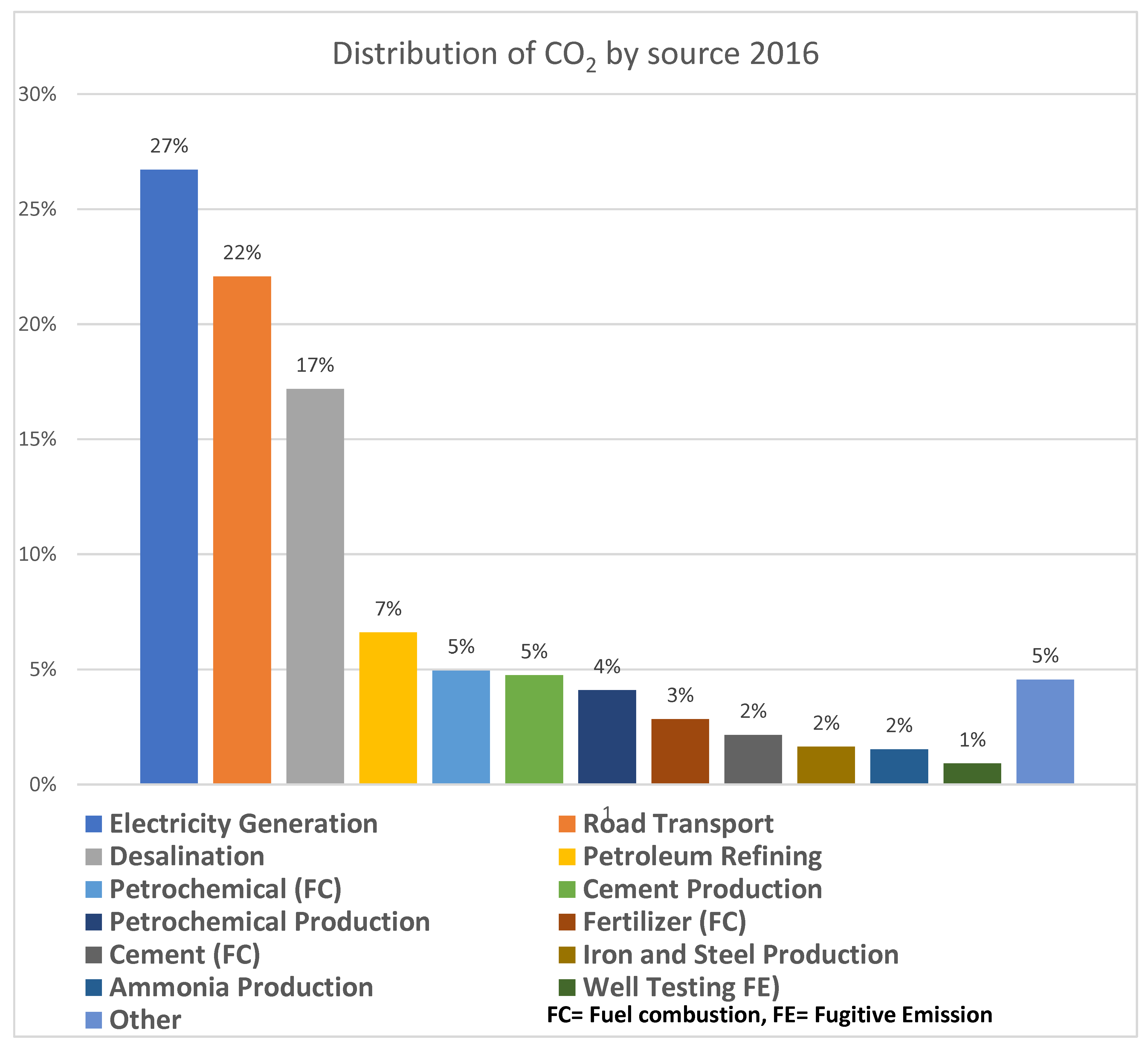
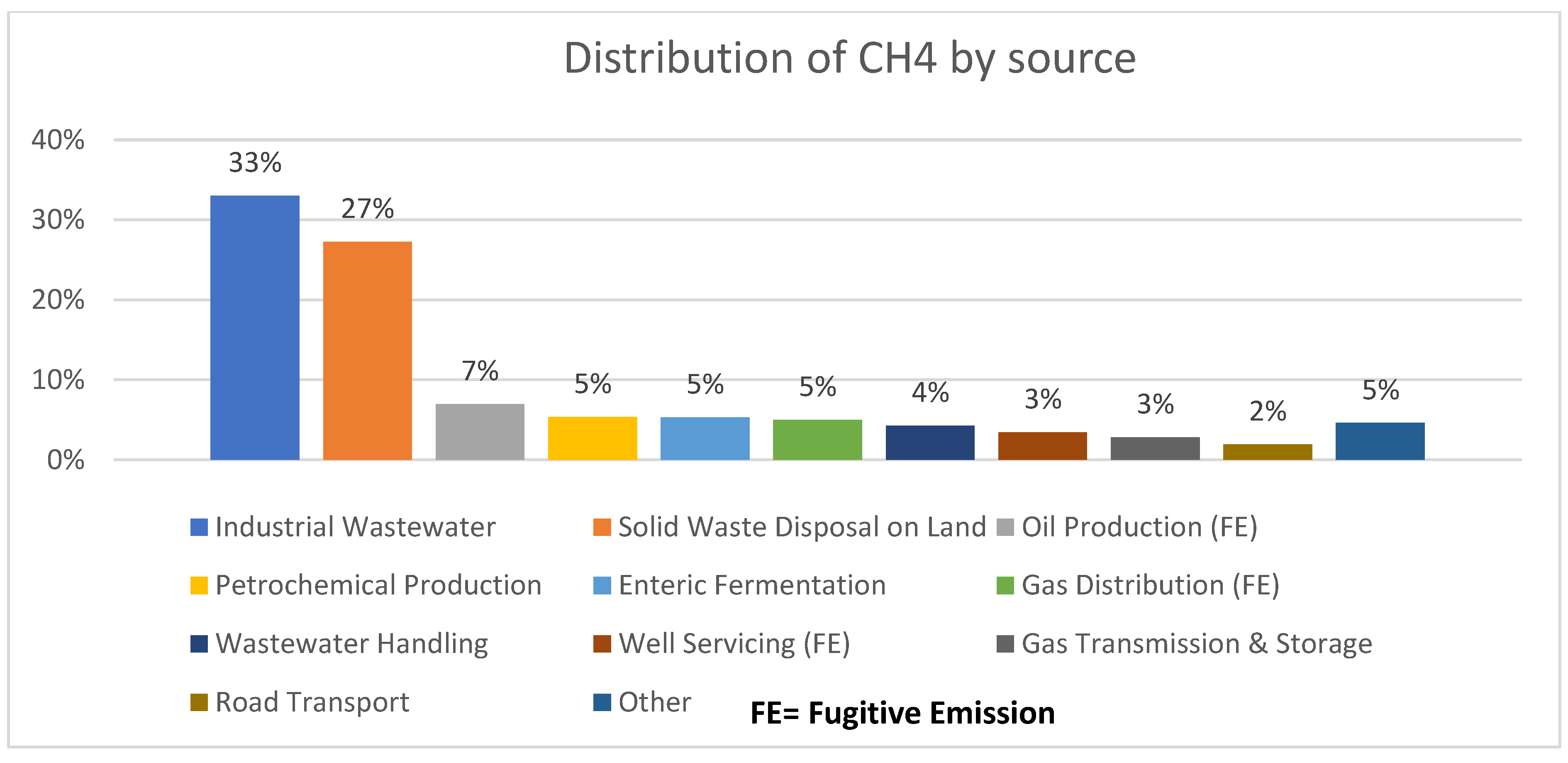


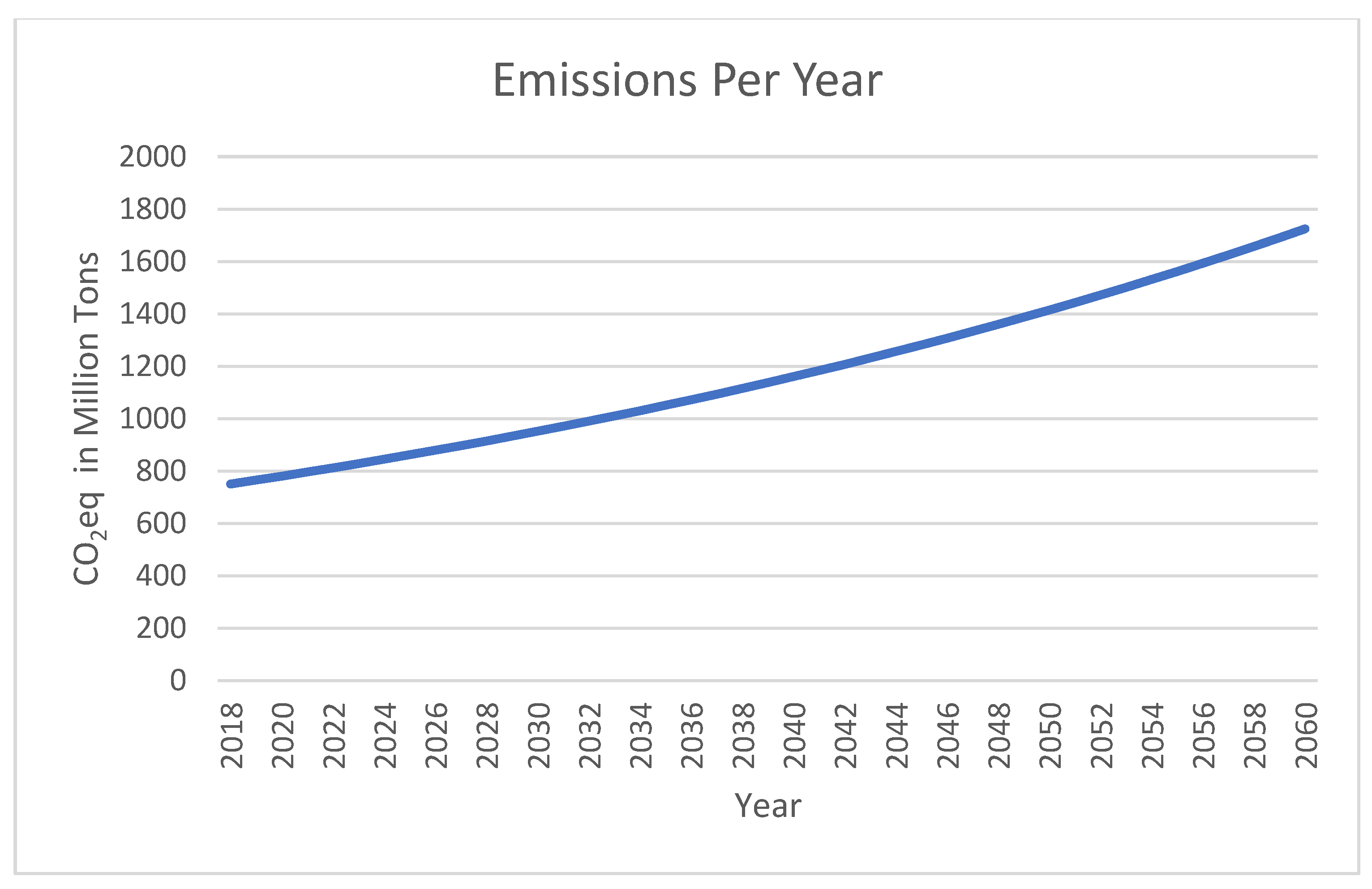
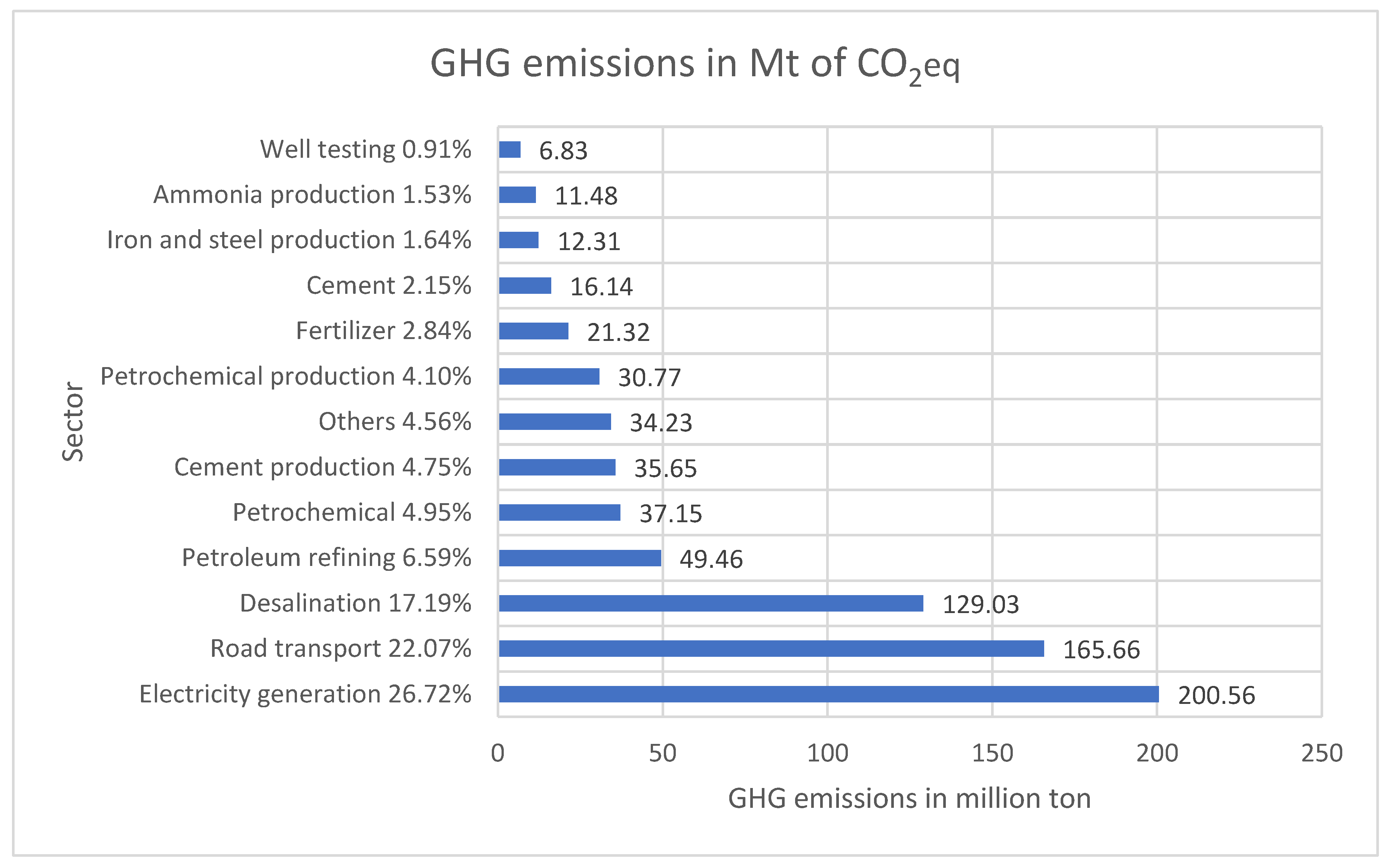

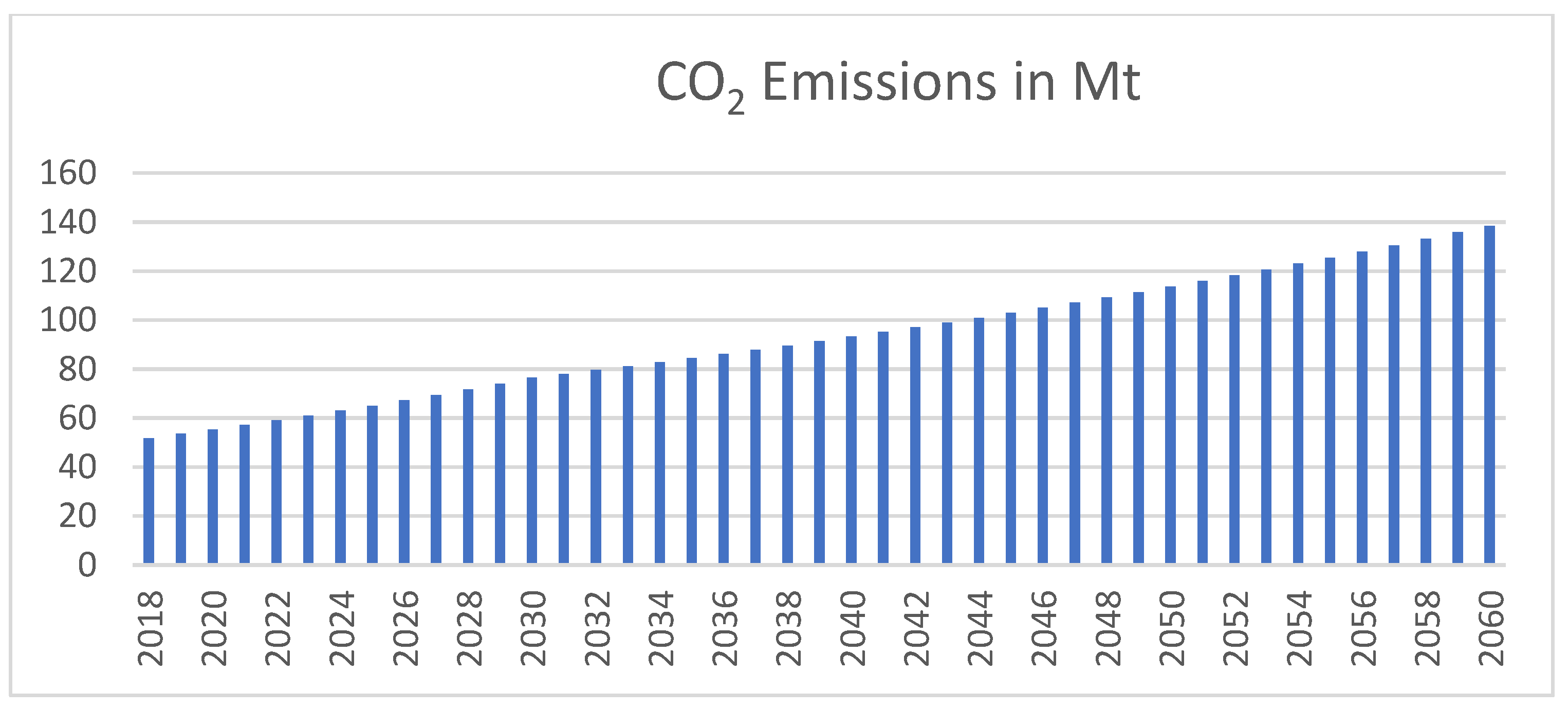
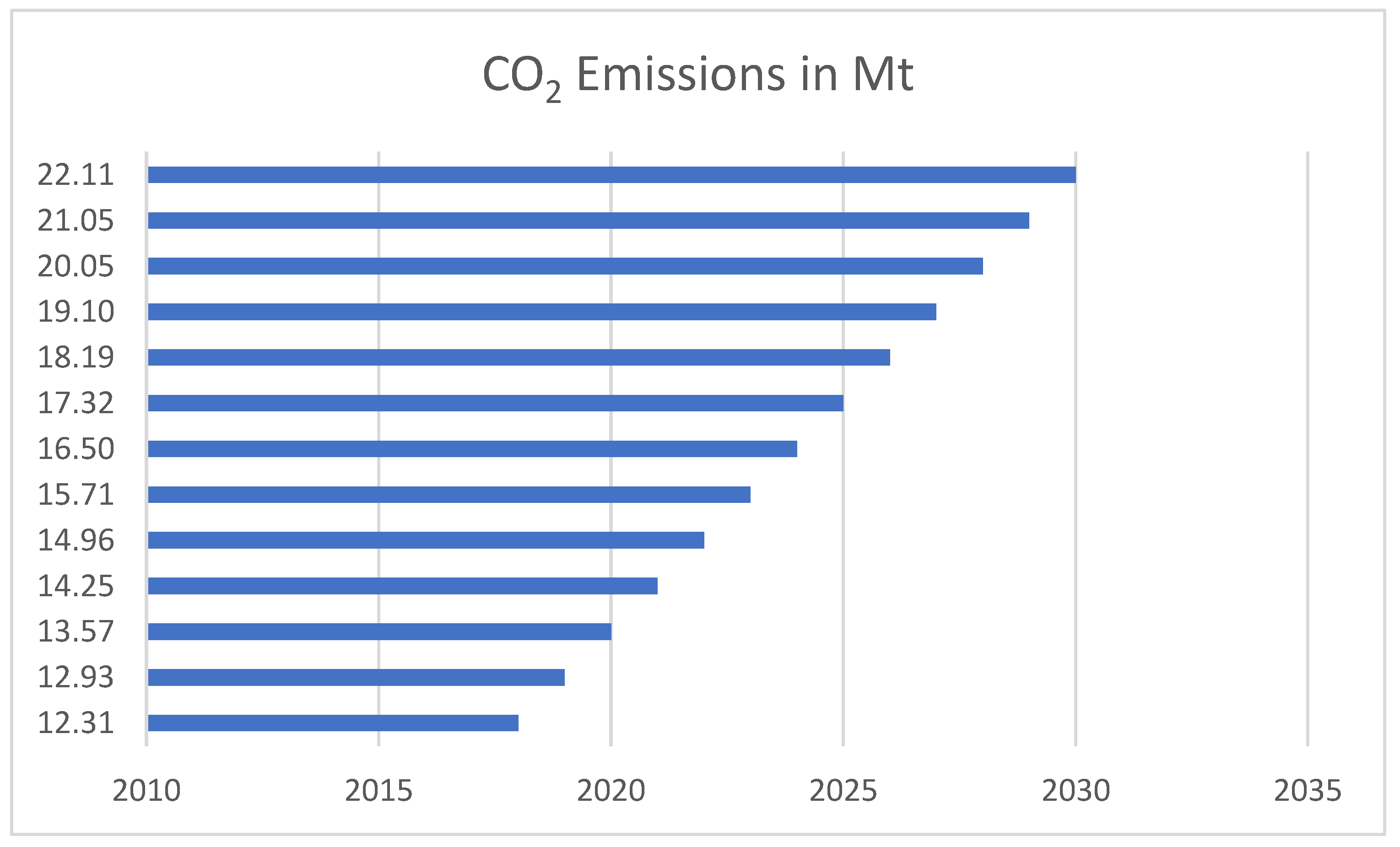
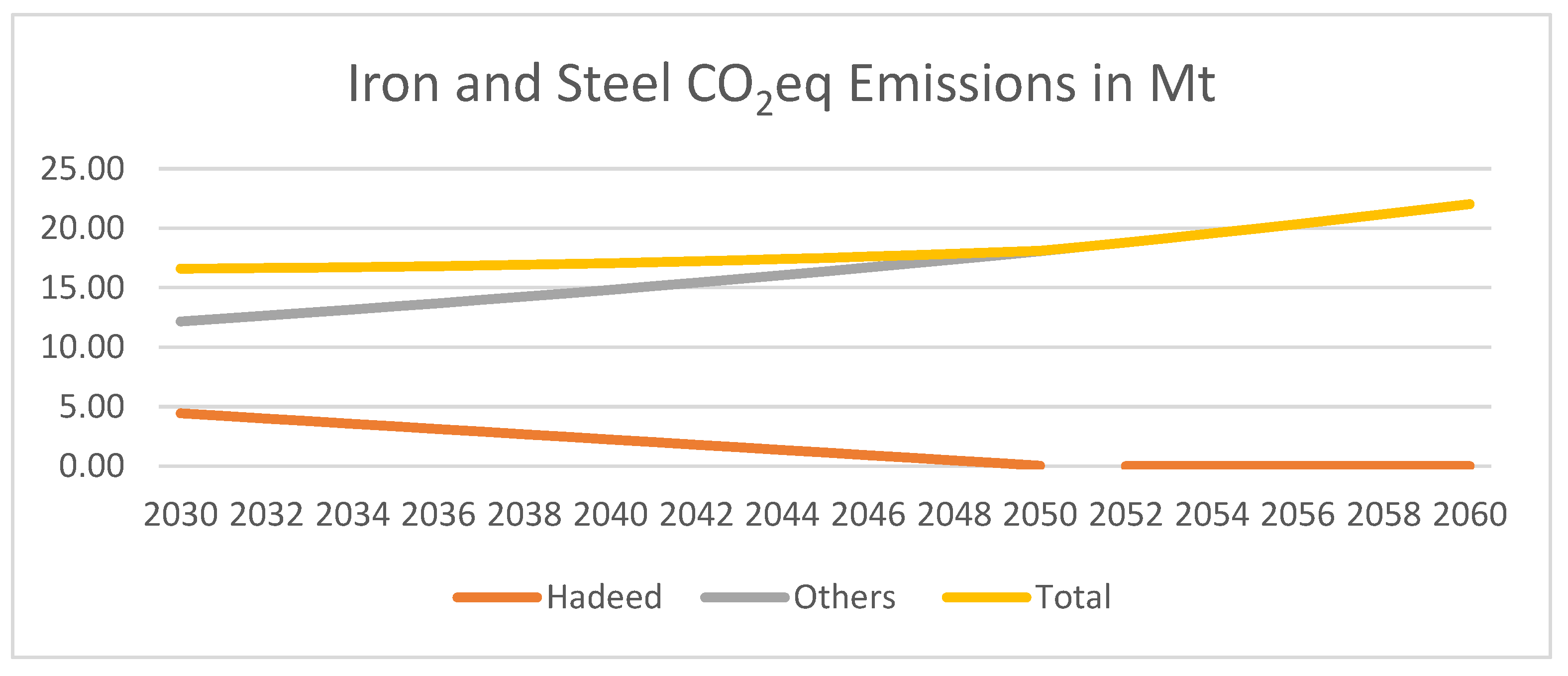
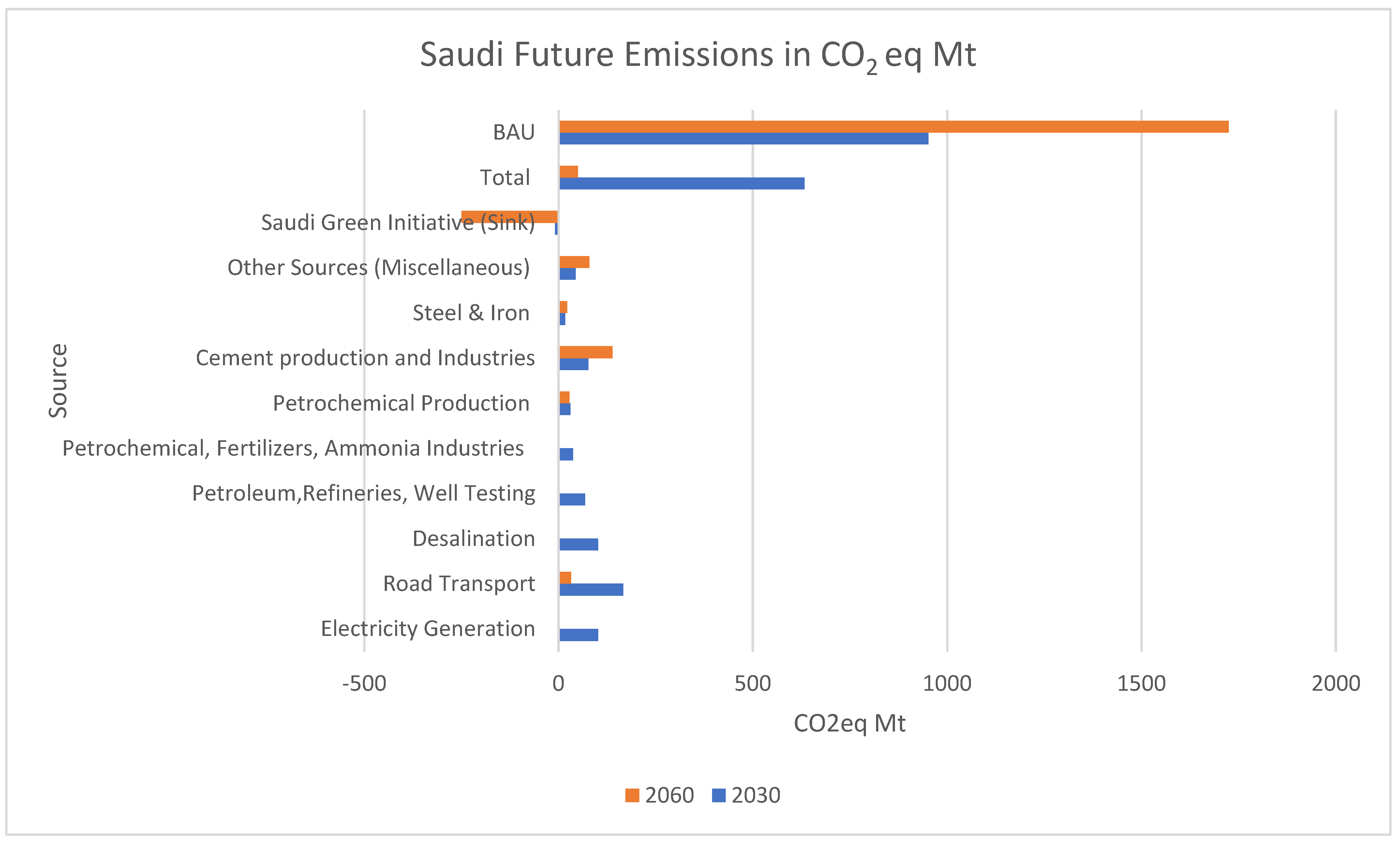
| Year | BAU Mt of CO2eq | Oil Fuel Mt of CO2eq | Gas Mt of CO2eq |
|---|---|---|---|
| 2018 | 200.56 | 104.29 | 96.27 |
| 2019 | 204.57 | 106.38 | 98.19 |
| 2020 | 208.66 | 108.50 | 100.16 |
| 2021 | 212.84 | 110.67 | 102.16 |
| 2022 | 217.09 | 112.89 | 104.20 |
| 2023 | 221.43 | 115.15 | 106.29 |
| 2024 | 225.86 | 117.45 | 108.41 |
| 2025 | 230.38 | 119.80 | 110.58 |
| 2026 | 234.99 | 122.19 | 112.79 |
| 2027 | 239.69 | 124.64 | 115.05 |
| 2028 | 244.48 | 127.13 | 117.35 |
| 2029 | 249.37 | 129.67 | 119.70 |
| 2030 | 254.36 | 132.27 | 122.09 |
Disclaimer/Publisher’s Note: The statements, opinions and data contained in all publications are solely those of the individual author(s) and contributor(s) and not of MDPI and/or the editor(s). MDPI and/or the editor(s) disclaim responsibility for any injury to people or property resulting from any ideas, methods, instructions or products referred to in the content. |
© 2023 by the authors. Licensee MDPI, Basel, Switzerland. This article is an open access article distributed under the terms and conditions of the Creative Commons Attribution (CC BY) license (https://creativecommons.org/licenses/by/4.0/).
Share and Cite
Al-Sinan, M.A.; Bubshait, A.A.; Alamri, F. Saudi Arabia’s Journey toward Net-Zero Emissions: Progress and Challenges. Energies 2023, 16, 978. https://doi.org/10.3390/en16020978
Al-Sinan MA, Bubshait AA, Alamri F. Saudi Arabia’s Journey toward Net-Zero Emissions: Progress and Challenges. Energies. 2023; 16(2):978. https://doi.org/10.3390/en16020978
Chicago/Turabian StyleAl-Sinan, Mazen A., Abdulaziz A. Bubshait, and Fatimah Alamri. 2023. "Saudi Arabia’s Journey toward Net-Zero Emissions: Progress and Challenges" Energies 16, no. 2: 978. https://doi.org/10.3390/en16020978
APA StyleAl-Sinan, M. A., Bubshait, A. A., & Alamri, F. (2023). Saudi Arabia’s Journey toward Net-Zero Emissions: Progress and Challenges. Energies, 16(2), 978. https://doi.org/10.3390/en16020978






